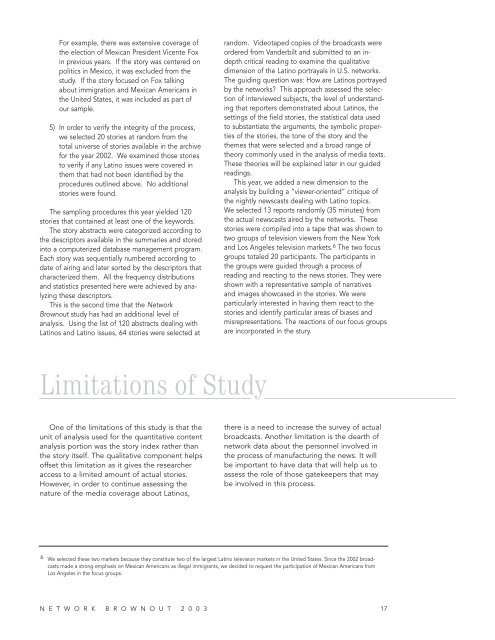You also want an ePaper? Increase the reach of your titles
YUMPU automatically turns print PDFs into web optimized ePapers that Google loves.
For example, there was extensive coverage of<br />
the election of Mexican President Vicente Fox<br />
in previous years. If the story was centered on<br />
politics in Mexico, it was excluded from the<br />
study. If the story focused on Fox talking<br />
about immigration and Mexican Americans in<br />
the United States, it was included as part of<br />
our sample.<br />
5) In order to verify the integrity of the process,<br />
we selected 20 stories at random from the<br />
total universe of stories available in the archive<br />
for the year 2002. We examined those stories<br />
to verify if any Latino issues were covered in<br />
them that had not been identified by the<br />
procedures outlined above. No additional<br />
stories were found.<br />
The sampling procedures this year yielded 120<br />
stories that contained at least one of the keywords.<br />
The story abstracts were categorized according to<br />
the descriptors available in the summaries and stored<br />
into a computerized database management program.<br />
Each story was sequentially numbered according to<br />
date of airing and later sorted by the descriptors that<br />
characterized them. All the frequency distributions<br />
and statistics presented here were achieved by analyzing<br />
these descriptors.<br />
This is the second time that the <strong>Network</strong><br />
<strong>Brownout</strong> study has had an additional level of<br />
analysis. Using the list of 120 abstracts dealing with<br />
Latinos and Latino issues, 64 stories were selected at<br />
Limitations of Study<br />
One of the limitations of this study is that the<br />
unit of analysis used for the quantitative content<br />
analysis portion was the story index rather than<br />
the story itself. The qualitative component helps<br />
offset this limitation as it gives the researcher<br />
access to a limited amount of actual stories.<br />
However, in order to continue assessing the<br />
nature of the media coverage about Latinos,<br />
random. Videotaped copies of the broadcasts were<br />
ordered from Vanderbilt and submitted to an indepth<br />
critical reading to examine the qualitative<br />
dimension of the Latino portrayals in U.S. networks.<br />
The guiding question was: How are Latinos portrayed<br />
by the networks? This approach assessed the selection<br />
of interviewed subjects, the level of understanding<br />
that reporters demonstrated about Latinos, the<br />
settings of the field stories, the statistical data used<br />
to substantiate the arguments, the symbolic properties<br />
of the stories, the tone of the story and the<br />
themes that were selected and a broad range of<br />
theory commonly used in the analysis of media texts.<br />
These theories will be explained later in our guided<br />
readings.<br />
This year, we added a new dimension to the<br />
analysis by building a “viewer-oriented” critique of<br />
the nightly newscasts dealing with Latino topics.<br />
We selected 13 reports randomly (35 minutes) from<br />
the actual newscasts aired by the networks. These<br />
stories were compiled into a tape that was shown to<br />
two groups of television viewers from the New York<br />
and Los Angeles television markets. 6 The two focus<br />
groups totaled 20 participants. The participants in<br />
the groups were guided through a process of<br />
reading and reacting to the news stories. They were<br />
shown with a representative sample of narratives<br />
and images showcased in the stories. We were<br />
particularly interested in having them react to the<br />
stories and identify particular areas of biases and<br />
misrepresentations. The reactions of our focus groups<br />
are incorporated in the stury.<br />
there is a need to increase the survey of actual<br />
broadcasts. Another limitation is the dearth of<br />
network data about the personnel involved in<br />
the process of manufacturing the news. It will<br />
be important to have data that will help us to<br />
assess the role of those gatekeepers that may<br />
be involved in this process.<br />
6 We selected these two markets because they constitute two of the largest Latino television markets in the United States. Since the 2002 broadcasts<br />
made a strong emphasis on Mexican Americans as illegal immigrants, we decided to request the participation of Mexican Americans from<br />
Los Angeles in the focus groups.<br />
N E T W O R K B R O W N O U T 2 0 0 3 17



